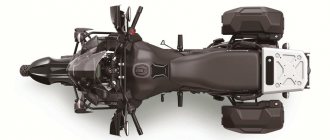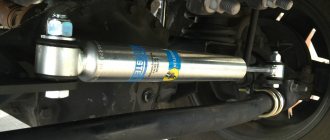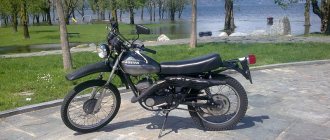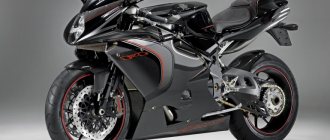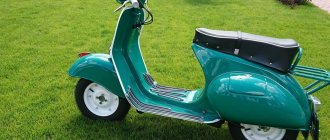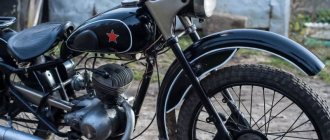- Why do you need a damper on a motorcycle?
- How to choose a damper for a motorcycle steering wheel
- Cost of damper for motorcycles
In the modern world, there are motorcycles with various design features.
Many motorcycle models are far from ideal. After all, manufacturers cannot foresee everything. During the operation of the motorcycle, the owners themselves determine what should be added to their bike so that riding it is comfortable and safe, and so that it lasts for many years. The steering wheel plays an important role while driving. It is allowed to direct the movement of the vehicle along the way. However, in many motorcycle models, this part of the motorcycle equipment has its drawbacks, which consist in poor-quality fastening. For this reason, on the road the steering may fail and an accident may occur. Therefore, you should purchase dampers for your bike.
000_moto_0612_086
The main concern when choosing a damper is its compatibility with your motorcycle model.
After all, such a rarity is usually brought to order. Before correcting the character of the motorcycle by installing a steering damper, tidy up the suspension and chassis. It’s a truism, but many people forget about it. The main concern when choosing a damper is its compatibility with your motorcycle model. After all, such a rarity is usually brought to order. Before correcting the character of the motorcycle by installing a steering damper, tidy up the suspension and chassis. It’s a truism, but many people forget about it.
Let's start with the theory. Any system can vibrate like a string. And like a string, any system has a certain resonant frequency. If external influences in their frequency approach the resonant frequency of the system, then the amplitude of its oscillations quickly increases - resonance occurs. A classic example of such a situation is a bridge along which a company of soldiers was marching. The frequency of their step coincided with the resonant frequency of the bridge, and the increased vibrations destroyed the structure. In the nineteenth century, several bridges fell because of this. After which the military were forbidden to keep pace on bridges.
The body of a motorcycle is no exception. This is also a system subject to resonance. And external vibrations (provoked by uneven roads or an unsuccessful landing from a wheelie) can rock it until it completely loses stability and controllability. Wobbling - a very unpleasant word for a motorcyclist - means an increasing swaying of the steering wheel to the right and left, and this often leads to a complete loss of control (and, as a result, to a fall). It is possible to reduce the likelihood of wobbling. First of all, for this it is necessary to maintain the motorcycle chassis and suspension in good condition. Worn or improperly adjusted shock absorbers increase the dangerous effect. But even a completely new motorcycle does not guarantee resistance to resonance. The steering damper is designed to help. In general, this part differs little from a hydraulic shock absorber, but has several important features.
A classic steering damper is a tube filled with oil with a rod and piston inside. The body is attached to the motorcycle frame, and the stem is attached to a rotating part of the steering system - usually a fork leg or triple clamp. As the piston moves, oil flows from one cavity to another through a small hole. If the piston damper has the ability to be adjusted, it means that the flow area of the hole through which the oil flows can be changed.
Most piston dampers are linearly adjustable. That is, the resistance of the damper in a normal situation, at a slow speed of rotation of the steering wheel, will be the same as when wobbling occurs. In other words, the damper is either too tight for comfortable taxiing, or too light to save you from unexpected bumpiness. For a track, this compromise is acceptable, because you won’t have to turn the steering wheel there. If the track does not have an ideal coating, you can tighten the damper more tightly. But for driving on roads it should not be overtightened.
Perhaps the only exception to this type of damper is the Hyperpro RSC series units, whose resistance increases with speed, allowing you to combine comfort and safety.
Much later than piston dampers, petal (rotor) dampers became widespread. Until the era of widespread introduction of computer design and CNC machines, their creation remained extremely expensive. But now the price of rotary dampers is comparable to the price of the best piston dampers. While there are no obvious disadvantages, rotor systems have three tangible advantages. The first is a significantly wider range of adjustments. Secondly, they are more compact and easier to install (if you have the right adapter). And third, rotary dampers do not suffer as much in falls as piston dampers. This is why they were loved by crossmen who had not previously used dampers at all.
How to choose a suitable damper? In the sports spare parts market, the rule still works quite reliably: more expensive means better. By choosing products from the most famous manufacturers, you can count on excellent results. What is the difference? Weight, fastening strength, as well as clarity and transparency of adjustments are what make a good damper stand out. But these qualities will be primarily appreciated by racers. For road motorcycle riders, the accuracy of adjustments is not important. The main thing is that unnecessary vibrations are extinguished at the right moment. Therefore, mid-price dampers are also suitable. I would exclude very cheap products as not entirely reliable.
Moving from theory to practice, you need to prepare for surprises. First of all, in our homeland such slow-selling goods are rarely found in stock and, as a rule, by accident. Therefore, the store usually takes an advance payment and delivers the part to order. And having received the long-awaited item, the client often wonders why he can’t get on the motorcycle. The nuances of the year of manufacture and model version can play a cruel joke. After all, sometimes there are many inaccuracies in the catalogs of tuning manufacturers, and the professionalism of online store employees is lacking. Therefore, check the order yourself (it’s a good idea to find on the Internet those who have already purchased such units and see them with your own eyes or ask them to take measurements). And it’s even better to buy such things where they can be installed. Then the installation problem will not become just your headache.
After installation, be sure to check that the steering wheel rotates freely within the extreme stops. The damper cannot and should not limit its travel. Also make sure that neither the body, nor the rod, nor the damper mounting brackets touch any parts of the chassis or trim of the motorcycle.
As soon as the desired item takes its rightful place on your motorcycle, you can begin adjusting. Everything is simple here. The steering wheel should turn easily. Otherwise, you will have problems when maneuvering and, even worse, the motorcycle will no longer accurately hold a straight line. If the motorcycle starts to feel loose during wheelie landings or when hitting bumps, tighten the adjusting screw one or two clicks and repeat the test.
And one more thing: often the cause of wobbling can be the pilot himself. An overly upright seating position and the way you grab the steering wheel with all your might at the first sign of vibration only enhance the effect. Therefore, if you feel something is wrong, move your weight forward and loosen your grip on the steering wheel. And may the damper help you!
Steering damper for motorcycle
Riding a motorcycle attracts a large number of people.
It offers great possibilities for travel and general trips around the city. Riding fast can have a detrimental effect on the technical condition of any motorcycle. This causes the steering wheel to become loose. As a result, the steering may fail. Therefore, it is necessary to use a damper on a motorcycle. It is available in various variants on the market. Motorcycle dealerships offer many options.
Dampers for motorcycles are used in situations where:
- the driver knows for sure that he will squeeze maximum speed out of his motorcycle.
- the driver is confident that he will take part in sports motorcycle competitions.
- the driver sees that his steering is not working well.
In order for the damper to work properly and securely fix the steering, it must be installed correctly. This will make you feel comfortable and safe during the journey.
Installing the damper is an easy task. Any motorcyclist can handle it. For this purpose, detailed instructions are attached to each such product. It will allow you to securely fix the steering wheel so that it does not become loose while driving.
001_moto_0612_086
Piston damper from the Swedish company Ohlins, one of the leaders in the field of racing hydraulics.
Ideal for the track. It has a linear characteristic and precision adjustment. A compensation chamber is needed in case the oil heats up. Fantastic style and quality. The price matches. Piston damper from the Swedish company Ohlins, one of the leaders in the field of racing hydraulics. Ideal for the track. It has a linear characteristic and precision adjustment. A compensation chamber is needed in case the oil heats up. Fantastic style and quality. The price matches.
What is it and how does it work
The name of the “lotion” is in English and comes from the verb damp, which is translated as “to extinguish”. The direct function of the damper, as it is also called, is to soften steering wheel vibrations. Wheels falling into potholes or crossing uneven, rocky terrain produce vibrations and impacts through the steering system. This reduces the degree of control over the car, and also forces the driver to make significant efforts to keep the steering wheel in the desired position. The damper in this situation plays the role of a kind of shock absorber, turning driving into a calm, smooth process.
The device is an oblong-shaped container containing oil inside. The reservoir cavity is divided in two by a movable partition equipped with valves. When the car is running, the baffle inside the damper begins to move, allowing oil to flow between the separated cavities thanks to adjustable holes.
The buffering effect of the damper depends on the size of the valves that control the flow rate of the lubricants. The larger the diameter of the adjustable hole, the softer the control of the machine will be. Conversely, the minimum size of the holes helps to increase the sensitivity and rigidity of the steering suspension.
The steering rack damper can be of two types:
- Telescopic. The partition has a piston design. The connection occurs through a moving rod.
- Rotary. A device of this type is connected to a rotating axis, and also has greater resistance to mechanical damage than the first type. Installed mainly on two-wheeled “iron horses”.
006_moto_0612_086
The Fastway damper from the American company PROMOTO Billet has as many as five adjustments.
You can adjust the resistance at slow and fast steering speeds, the resistance when returning to the center position, the angle of rotation at which the damper force is reduced, and the degree of reduction. Do you need that much? Yes, if instead of training you are carried away by fiddling with the settings. The Fastway damper from the American company PROMOTO Billet has as many as five adjustments. You can adjust the resistance at slow and fast steering speeds, the resistance when returning to the center position, the angle of rotation at which the damper force is reduced, and the degree of reduction. Do you need that much? Yes, if instead of training you are carried away by fiddling with the settings.
Without hesitation: install a steering damper
Cost of damper for motorcycles
Every modern motorcyclist should be prepared for the fact that purchasing additional elements and spare parts for a motorcycle can cost a large amount. Dampers from different manufacturers have different prices. It can reach several tens of thousands of rubles.
On average, in our country, dampers for different models of motorcycle equipment cost approximately 18 thousand rubles. You can choose your own option for each motorcycle model individually.
However, it is worth noting that the more expensive your vehicle, the more you will have to pay to equip it with everything you need. Dampers for imported motorcycle models and expensive models of sports bikes cost owners from 50 thousand rubles.
Without a damper, the motorcycle will incur higher costs if the steering fails. After all, carrying out repair work along with purchasing new spare parts will cost much more than purchasing one small element that prevents breakdown.
Advantages and disadvantages
If the installation rules are followed, as well as its expediency, the time spent behind the wheel becomes more comfortable.
Car modification allows you to:
- improve control in conditions of increased road roughness;
- reduce driver hand fatigue;
- improve the condition of tires due to more uniform tread wear.
The operation of the device is aimed at maintaining a steering wheel position that guarantees stable, straight movement. However, this feature may become a disadvantage in cases requiring sharp turns - changing the position of the steering wheel will require some effort.
